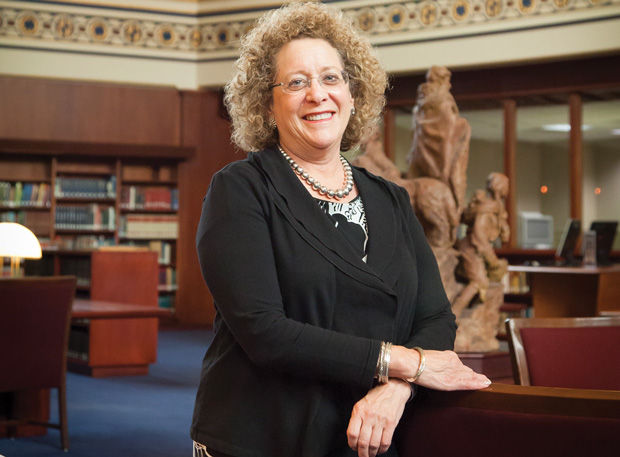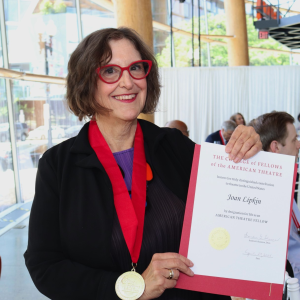New History Museum leader shares new New Year tradition
Published September 4, 2014
Editor’s note: Frances Levine became president of the Missouri History Museum in April. She wrote this article about Rosh Hashanah while living in New Mexico, where she directed the New Mexico History Museum and Palace of the Governors.
As the Jewish holidays approach each year, I pull out my cookbooks to consider what I will make to contribute to the holiday meals that we share with family and friends. First, let me explain that many of our family members are more than culinary Jews, but certainly less traditional than my Conservative paternal grandparents, and more traditional than my maternal grandmother, who always liked the church services at St. Ann’s in Greenwich, Conn., better than she liked the temple my parents belonged to in Fairfield, Conn.
Among my generation, dozens of close first and second cousins embrace the world’s great and minor religions from atheist to whatever. We like to gather at the holidays – any holiday will do – and cooking with, and for, one another is part of the plan. This year, several of us will gather at my home.
I almost always start with my mother’s stained but sturdy “Jewish Holiday Cooking.” Scattered throughout the book are her notes and variations on recipes for her holiday favorites. There in my mom’s careful, recognizable handwriting is her recipe for rugalach, yum, though I really can’t in good conscience offer a desert made with that much sugar and butter (yes, she used butter unless they were to be consumed after eating meat, and then she made it with “oleo”).
Better to serve my brother’s delicious, healthy fruit salad made with oranges, dates, pomegranate and pistachios. That’s settled. But just in case, someone else can bring the apple pie and hard sauce that is the featured dessert of a favorite local restaurant.
Kale salad has found its way to the table in the past few years, and it is a must. Laced with almonds and a lemony, Caesar dressing, it is a meal in itself. The bread is a no brainer — challah — unless I decide, like this year, that a round, rosemary sourdough is just as symbolic. Sourdough, really? Sure, this is New Mexico, and sourdough was the food of real cowboys and cowgirls. Nice Jewish cowboys and cowgirls would love that bread, and so much more in keeping with the rest of a meal that was growing to be an interesting mix of Sephardic, Ashkenazi, Hispanic and cowboy cooking.
I still couldn’t settle on the main dish. That is always hard in our home, where the children (now adults) have been vegetarians for almost a decade. Although they rarely come home for the Jewish holidays, I still think of them when I plan the menu of any gathering. Then there are all my food neuroses: Is the meat free range, organic? Does that make a difference anyway? Did the cows receive too many antibiotics? How many is too many? I wonder if that chicken I might cook roamed the range freely enough to make it to my table.
This year, I decide I want to make something to honor the memory of my dear sister, who died less than a year ago. For her, each holiday had a simple and never varied menu. Rosh Hashanah meant brisket. BRISKET, oh, no, I don’t know how to make a brisket. Would one even fit into my oven? Aren’t they the size of a whole side of a cow? Each time I realize I cannot call my sister to ask her advice, I weep a little. I know I have to take control of my feelings and get this dinner, which I decided to host, organized. My husband has been terrifically supportive of my grief but really wishes I would just make a menu already without the drama.
So out they come again, all the cookbooks. This takes me on a kind of culinary, anthropological odyssey. Did I mention that I am an anthropologist? That’s important here because it leads me to spend several evenings comparing the food traditions surrounding brisket as cooked by Jews of various ethnic backgrounds.
Jewish brisket covered in onions is never gonna work for me. And forget it, anyway, because the recipe begins by directing me to pat the meat dry and then brown it evenly on all sides for nearly 40 minutes. Then I discovered the Texas varieties of barbecued brisket. Brown sugar on a brisket, no way. OMG, one of these recipes even calls for Coca Cola. Dry rubbed? Sounds painful.
Soon I begin to see the single thread that unites all the brisket recipes: slow roasting. I even find a cowboy cookbook from a legendary southern Texas ranch that includes a brisket recipe without first browning. The recipe calls for a mixture of dry mustard and chile powder, which is something that speaks to my New Mexican taste buds.
So I begin, but substitute a tangy red chile mustard for the chile powder and dry mustard. I gently rub the mixture of red chile mustard and herbs over the slab of meat. I roast it for an hour at 350, or was it 375? I pour over it a mixture of sliced mushrooms and soaked sun-dried tomatoes (OK, that was not an ingredient from the cowboy cookbook – it came from a nouveau Jewish cookbook). I add an inch of a basting sauce I make with the sundried tomato juices, some red wine (which I first drink to make sure it is not too sweet) and some mushroom broth. Then I seal it all up and turn the temperature down to 300 (or was it 275?) and close the oven door. I finish the glass of wine, then sail out of the house to get my nails done. Perfect timing, I’d say.
Back in three hours and a wonderful aroma of meat, mushrooms and wine greets me as I sweep into the house. I reel off a list of things to do before the guests arrive. Better make a dish with apples, after all, so I quickly grate some apples and sweet potatoes and sauté them in butter and finish them with lime and tequila.
When the guests arrive, it’s all looking good. My husband has set the tables outside on the porch with its perfect framing of the mountains at sunset. He has served Rabbi Ben, our agnostic sage, a stiff and fragrant single malt Scotch. A friend and I attend to the brisket slicing while my cousin from Texas helps make the gravy from the pan drippings. I ask the rabbi for a blessing, and he responds characteristically: “Enough prayers, we’ve been at it all day.”
Then we sit down to eat, each person first dipping an apple slice in the honey and wishing each other a sweet new year. As the brisket is served, the Jews at the table look for the nonexistent onions, and the Texans look for the barbecue sauce. Each looks a little disconcerted but then accepts my offering of this adulterated form of brisket with grace.
Soon the table is filled with guests smiling with satisfaction. Each guest leaves with a copy of the recipe, and I am swollen with pride and way too much food.
“What should we call it?” a friend asks.
“Shiksa’s Brisket,” says another.
Not too PC, but certainly it is a recipe that neither my Jewish mother nor my cowboy friends, not even the nice Jewish cowboys and cowgirls I know, would make. Somewhere, my sister is laughing, though she may be appalled by the way I altered, perhaps even obliterated, a longstanding holiday tradition.
But it did the trick. It created a new holiday tradition, and my own set of endnotes and side notes in the cookbook. Only this time, it is in a ranch cookbook, not the “Jewish Holiday Cookbook.”















